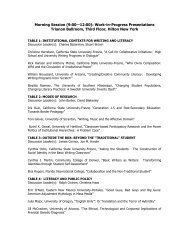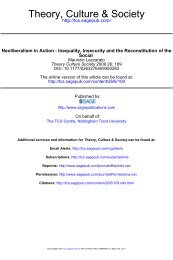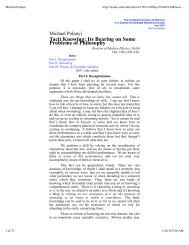PUBLIC OPINION by WALTER LIPPMANN TO FAYE LIPPMANN ...
PUBLIC OPINION by WALTER LIPPMANN TO FAYE LIPPMANN ...
PUBLIC OPINION by WALTER LIPPMANN TO FAYE LIPPMANN ...
Create successful ePaper yourself
Turn your PDF publications into a flip-book with our unique Google optimized e-Paper software.
seasons. If born in winter, we should believe in summer as we now<br />
believe in the heats of the carboniferous era. The motions of organic<br />
beings would be so slow to our senses as to be inferred, not seen. The<br />
sun would stand still in the sky, the moon be almost free from change,<br />
and so on. But now reverse the hypothesis and suppose a being to get<br />
only one 1000th part of the sensations we get in a given time, and<br />
consequently to live 1000 times as long. Winters and summers will be<br />
to him like quarters of an hour. Mushrooms and the swifter growing<br />
plants will shoot into being so rapidly as to appear instantaneous<br />
creations; annual shrubs will rise and fall from the earth like<br />
restless boiling water springs; the motions of animals will be as<br />
invisible as are to us the movements of bullets and cannon-balls; the<br />
sun will scour through the sky like a meteor, leaving a fiery trail<br />
behind him, etc."<br />
5<br />
In his Outline of History Mr. Wells has made a gallant effort to<br />
visualize "the true proportions of historical to geological time"<br />
[Footnote: 1 Vol. II, p. 605. See also James Harvey Robinson, _The<br />
New History,_ p. 239.] On a scale which represents the time from<br />
Columbus to ourselves <strong>by</strong> three inches of space, the reader would have<br />
to walk 55 feet to see the date of the painters of the Altamara caves,<br />
550 feet to see the earlier Neanderthalers, a mile or so to the last<br />
of the dinosaurs. More or less precise chronology does not begin until<br />
after 1000 B.C., and at that time "Sargon I of the Akkadian-Sumerian<br />
Empire was a remote memory,... more remote than is Constantine the<br />
Great from the world of the present day.... Hammurabi had been dead a<br />
thousand years... Stonehedge in England was already a thousand years<br />
old."<br />
Mr. Wells was writing with a purpose. "In the brief period of ten<br />
thousand years these units (into which men have combined) have grown<br />
from the small family tribe of the early neolithic culture to the vast<br />
united realms--vast yet still too small and partial--of the present<br />
time." Mr. Wells hoped <strong>by</strong> changing the time perspective on our present<br />
problems to change the moral perspective. Yet the astronomical measure<br />
of time, the geological, the biological, any telescopic measure which<br />
minimizes the present is not "more true" than a microscopic. Mr.<br />
Simeon Strunsky is right when he insists that "if Mr. Wells is<br />
thinking of his subtitle, The Probable Future of Mankind, he is<br />
entitled to ask for any number of centuries to work out his solution.<br />
If he is thinking of the salvaging of this western civilization,<br />
reeling under the effects of the Great War, he must think in decades<br />
and scores of years." [Footnote: In a review of _The Salvaging of<br />
Civilization, The Literary Review of the N. Y. Evening Post_, June<br />
18, 1921, p. 5.] It all depends upon the practical purpose for which<br />
you adopt the measure. There are situations when the time perspective





